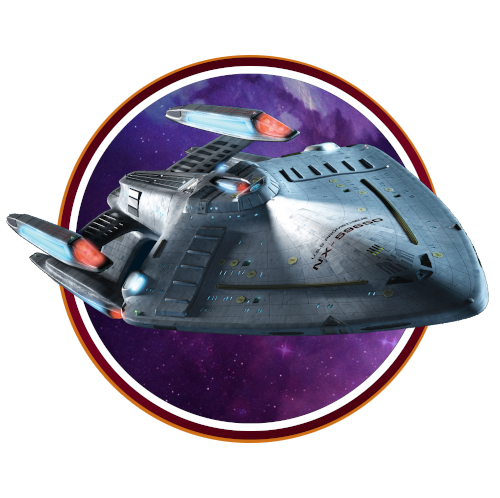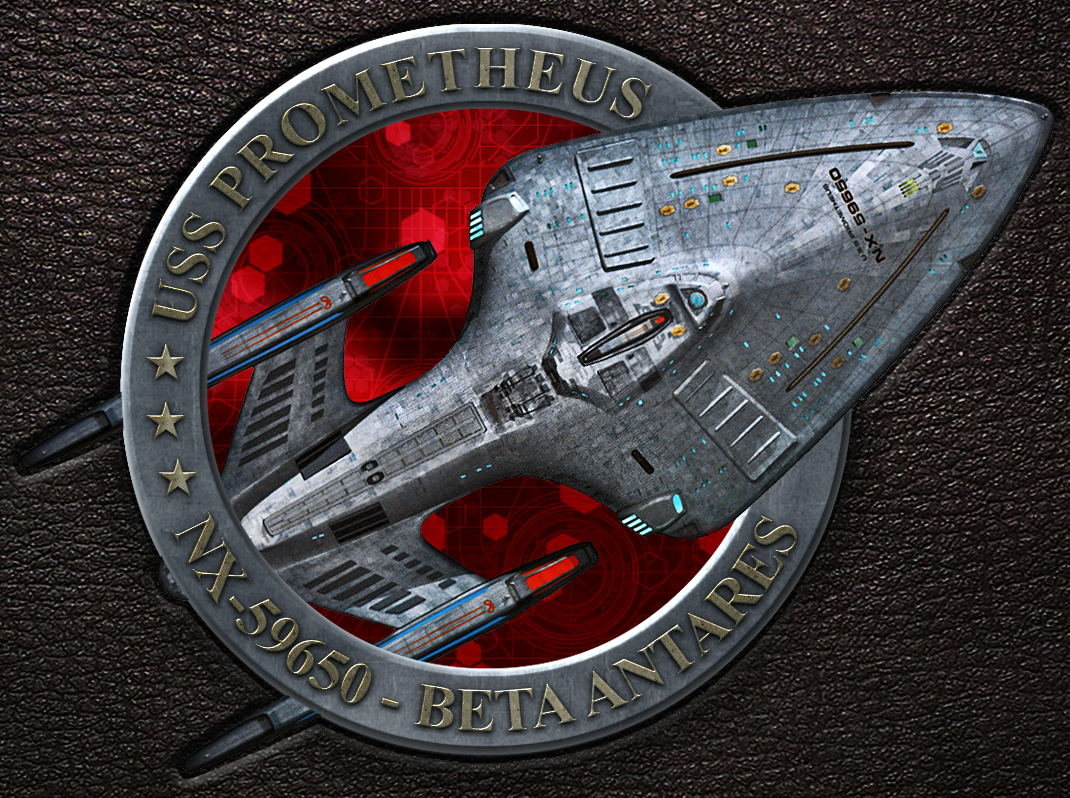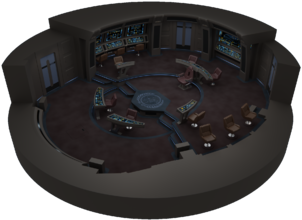USS Prometheus

| |
| USS Prometheus | |
| General Information | |
| Registry | NCC-74913 |
| Class & Type | Prometheus-class escort |
| Affiliation | Starfleet |
| Status | Active |
| Commissioned | 2370's |
| Assignment | |
| Role | Heavy Escort |

| |
| Template:Starship | |
- "All the World's a stage and all the men and women merely players, they have their exits and entrances and one man in his life plays many parts, his act being seven stages… "
- —William Shakespeare - Ship's Dedication Quote
At the time of her launch in 2373, Prometheus was a technological marvel, an experimental vessel designed for deep space tactical engagements with significant advancements in many systems all contained in one space frame. Regenerative shielding, ablative hull armour, holographic projectors on every deck, allowing the EMH unrestricted access across the entire ship and a warp core that made her the fastest ship ever built by Starfleet. All of her technological advancements meant that she had a high level of automation, reducing her crew capacity somewhat. Such a technological leap forward proved too hard to resist for the Federation's enemies, and the ship was hijacked by Romulans during her routine shakedown in 2374. During this time, the ship's unique multi-vector assault mode (MVAM) was activated for the first time, and helped to prove the ship's tactical capabilities.
Over the course of the next few years, Prometheus took part in the final engagaements of the Dominion War, and then spent many a day conducting missions beyond Federation space. Routine maintenance of her complicated systems drew the ship back to Earth in 2378, which was fortunate as another crisis threatened to engulf the homeworld of the Federation. Upon the detection of a Borg transwarp aperture near Earth, Starfleet was placed on high alert. Prometheus and twenty-six other starships were dispatched by Admiral Owen Paris to intercept whatever Borg threat would emerge. Soon, a Borg Sphere would emerge, and all of the ships opened fire, with Prometheus assisting in its destruction. Following the emergence of the USS Voyager from the debris, the Prometheus escorted Voyager back to Earth in a moment of triumph.
For much of the next twenty years, very little is accessible about the endeavours that Prometheus has undertaken. It is known that she was part of the Starfleet force dispatched to the Romulan border following the destruction of a rescue armada on Mars in 2385, and again two years later when the Romulan supernova obliterated dozens of Romulan star systems. Prometheus would protect the Starfleet border, and refugees that were accepted into Federation space.
Some time later, Prometheus would be recalled for essential repairs and a significant refit in 2399, but the shakedown cruise that followed was put to a halt thanks to the Century Storm crisis in January of 2400. It is unclear what role she played during the crisis, but rumours persist that she was involved in tactical maneuvers against the Klingon Hunters of D'Ghor.
Later that same year, Prometheus would be ordered to Deep Space 17 where she would be assigned a new commanding officer, Captain Keziah Nazir, and a mission far beyond the border of Federation space and into the Typhon Expanse as part of the newly formed Prometheus Squadron. Following the ship's first mission with the squadron, her command crew was reassigned, and Prometheus was reassigned to other duties..
Commanding Officer Lineage
- 2374-2378: Captain James Ryan (Human Male)
- 2384-2390: Captain Ona Battley (Human Female)
- 2395-2400: Captain Thrax (Bolian Male)
- 2400-2401: Captain Keziah Nazir (Trill Female)
Multi Vector Assault Mode
Multi-vector assault mode is a unique feature developed by Starfleet for the Prometheus-class starship in the 2370s. By using advanced compartmentalization and automation systems, upon calling for multi-vector assault mode, the ship could split itself into three separate warp-capable vessels, becoming an entire squadron operating semi-independently and in concert with one another. Key facts about the operation of MVAM include:
- When MVAM is ordered, blue alert commences and a ten second countdown begins.
- All sections, unless otherwise specified, will separate. Separation is generally performed at sublight speeds, but is also possible at warp.
- Alpha section separates from Beta section at deck nine, and deploys two warp nacelles (both dorsal and ventral) of the main hull.
- Beta section separates from Gamma section along the X-axis at deck nine/ten, with each section having two of the four standard nacelles.
- Following separation, the separate sections can be piloted manually, or are controlled by the ship's computer to perform pre-programmed attack patterns.
- After MVAM operations, the ship is capable of re-connecting itself automatically upon the command being given to commence reconnection.
Key Location Data
Due to the unique separation capabilities of the Prometheus, the ship is split into three warp capable sections (Alpha, Beta and Gamma sections), with many important facilities duplicated for each section. As such, the deck layout for the ship can be quite complicated. Facilities marked in bold are the main facilities that will be in use during normal operating procedures, with duplicated facilities performing minor functions only during these times.
Bridge, Deck One
Modelled on the successful layout of its older, larger cousin the Sovereign-class, the bridge of the Prometheus is a radical redesign from previous bridge modules of the class, with a much altered colour scheme and a significantly different console layout across the bridge. Making the most of a variety of technological advancements, such as holoprojectors, holographic communications, in-built weapons lockers and three dimensional computer displays in places, the new Prometheus-class bridge module is one of the most advanced in the fleet. Perhaps one of its most charming features is the emblem of the United Federation of Planets emblazoned on the carpeting as a constant reminder of all the ship stands for, even when so far from home.
In a move away from more recent styles, and harking back to the traditional layouts of yesteryear, the Prometheus has a single center command seat for the commanding officer. Directly head of them, down a few steps and between the commanding officer and the holographic viewscreen, two angled consoles serve as duty stations for Operations (port) and Flight Operations (starboard). Next, and facing into the heart of the bridge to allow maximum participation with the rest of the bridge crew are duty stations for science (port) and tactical operations (starboard). Directly behind the commanding officer, and in a further break from tradition, a combined duty station serves as positioning for the two most senior advisors and assistants to the ship's commander; the Strategic Operations Officer (port) and Executive Officer (starboard). Around the outside of the bridge, there are countless other additional stations. Behind the main science station on the port bulkhead, additional science and medical consoles are available for mission operations, as well as access to life support and environmental controls. Adjacent to them on the starboard bulkhead, mission operations and security stations ensure the continued safety of the ship and crew on a day to day, mission by mission basis. On the aft bulkhead, engineering is the focus. With a large, entirely interactive and customizable master systems display (MSD) and other engineering controls, the representative from engineering has full access to the ship's systems.
Around the command center, four doors provide access to and from the bridge. On the forward port bulkhead, access is available to the observation lounge, whilst the starboard door grants access to the commanding officer's private ready room (available for use by any officer in command of the ship). At the aft of the bridge, both doors provide access to turbo lifts which enable the crew to access the command center from the rest of the bridge. The starboard turbo lift grants express, overridden access to key locations such as the battle bridges, engineering, shuttlebay 1, sickbay, tactical astrometrics and transporter rooms 1 and 2.
